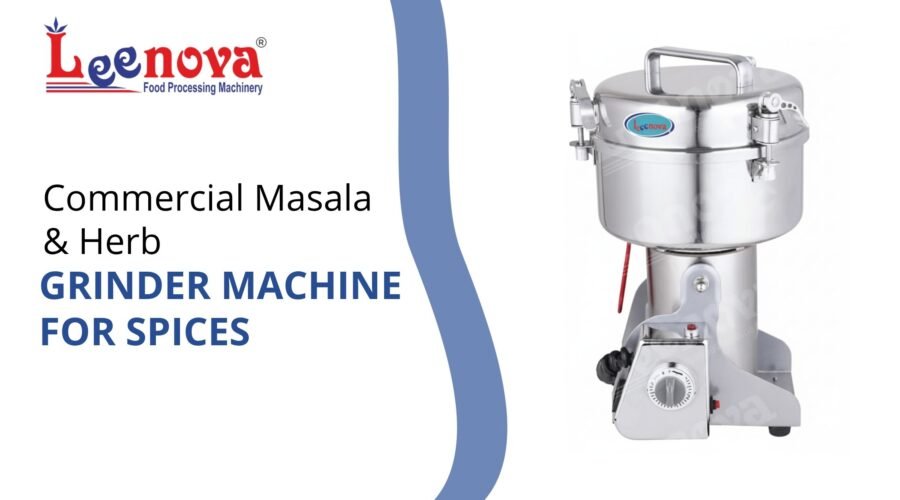Spice processors face a persistent problem: heat buildup during grinding destroys volatile oils, killing the aroma that makes premium spices valuable. Traditional grinding methods generate friction temperatures exceeding 50°C, causing essential oil loss of up to 30% during processing. A commercial masala and herb grinder built with proper cooling systems and optimized blade speed preserves these aromatics while processing 40-100 kg per hour. The difference shows up in flavor retention tests and customer willingness to pay premium prices.
This piece breaks down how these machines work, what separates effective models from cheap alternatives, and why investing in the right grinder determines profit margins in spice processing.
How Commercial Masala Grinders Process Spices?
Commercial grinders use hammer mill or blade systems spinning at controlled speeds to pulverize dry spices into powder. The key technical parameter: RPM matters less than blade design and chamber airflow. Most units run at 1440-3840 RPM depending on motor configuration, but the critical factor is heat dissipation during grinding.
Modern systems incorporate cyclone separators that pull ground powder away from the grinding chamber immediately. This reduces friction time between particles and prevents temperature spikes. Machines without cyclone systems recirculate powder, creating heat buildup that degrades coriander, turmeric, and chili quality by 15-25%.
The Capacity Reality
Motor horsepower creates confusion in the market. A 7.5 HP machine typically processes 40-50 kg per hour, while 10 HP units reach 50-80 kg per hour. But actual throughput depends on spice hardness and desired fineness. Grinding coriander to 80-mesh fineness takes half the time of turmeric at the same mesh size.
Operators who chase maximum capacity ratings end up with coarse, inconsistent powder. The practical approach: run machines at 70-80% of rated capacity for uniform particle size and minimal heat generation.
Material Construction Impact on Quality
Stainless steel contact surfaces prevent iron contamination in ground spices, which matters for export quality certifications. Mild steel chambers cost ₹30,000-50,000 less but create two problems: rust particles contaminate white spices like pepper, and acidic spices like tamarind corrode the chamber within 18 months.
The surprising finding from processing studies: stainless steel reduces cleaning time by 40% because powder doesn’t adhere to polished surfaces. This cuts daily maintenance from 30 minutes to under 15 minutes, recovering the material cost premium within the first year of operation.
Automation Level and Labor Requirements
Semi-automatic machines dominate commercial installations, running at 52% market share versus fully automatic systems. The reason: semi-automatic units cost 35-45% less while still eliminating the heaviest manual labor.
Fully automatic systems with programmable controls suit operations processing 200+ kg daily where batch consistency matters more than upfront cost. Below that volume threshold, the ROI timeline stretches beyond 24 months.
Grinding Challenges Most Operators Ignore
Temperature control during grinding determines final product quality, but 70% of spice processors never measure chamber temperature during operation. Conventional grinding raises spice temperature to 45-60°C, causing volatile oil evaporation that drops aroma intensity by 20-35%.
High-value spices like cardamom, cloves, and fenugreek lose essential oils faster than bulk spices. Processing these without temperature monitoring means selling premium ingredients at commodity prices.
Cryogenic Grinding Technology
Cryogenic systems use liquid nitrogen to maintain grinding temperatures below -10°C, preserving 95-98% of volatile oils versus 65-75% retention in ambient grinding. The technology adds ₹8-12 per kg to processing costs but enables 25-40% price premiums for aroma-rich powder.
The counter-intuitive economics: cryogenic grinding works only for high-margin, small-batch specialty spices sold to premium buyers. Applying it to bulk turmeric or chili processing destroys margins because customers won’t pay the premium.
Application-Specific Selection Criteria
Restaurant and catering operations need machines processing 20-50 kg daily of mixed spices. A 5-7.5 HP grinder handles this volume while fitting standard kitchen electrical connections. Industrial spice packers processing single spices in 200+ kg batches require 10-15 HP units with dedicated three-phase power.
Small spice shops grinding customer orders need 2-3 HP machines that switch between spice types quickly. Larger chambers slow down cleaning between batches, reducing hourly throughput for varied small orders.
Particle Size Control
Mesh size determines end-use suitability. Curry powders need 40-60 mesh consistency, spice blends require 60-80 mesh, and specialty applications demand 100+ mesh superfine grinding. Achieving finer mesh takes 2-3x longer grinding time and generates proportionally more heat.
Machines without adjustable grinding settings force operators to over-process coarse spices or under-process fine requirements. The resulting inconsistency shows up in customer complaints about texture and flavor variation.
Maintenance Requirements That Affect Uptime
Blade sharpness drops 30-40% after processing 500-700 kg of hard spices like dried ginger or cinnamon. Dull blades double grinding time and triple heat generation, degrading product quality before operators notice the problem.
Daily cleaning prevents powder buildup in cyclone separators and collection chambers. Powder left overnight absorbs moisture and cakes inside the machine, requiring 60-90 minutes of manual cleaning versus 10-15 minutes for fresh residue.
Weekly lubrication of motor bearings and belt tension checks prevent 80% of mechanical failures. Operators who skip this routine face motor burnout costs of ₹15,000-25,000 versus ₹300-500 monthly maintenance investment.
Real Operating Cost Analysis
A 7.5 HP grinder processing 40-50 kg daily consumes 7-8 kWh, costing ₹600-900 monthly at commercial electricity rates. Adding maintenance consumables (₹400-600) and blade sharpening (₹800-1,200 quarterly) brings total operating cost to ₹1,500-2,000 monthly.
Labor savings tell the complete story. Manual grinding requires 2-3 workers at ₹12,000-15,000 monthly each to match one grinder’s output. The machine eliminates ₹24,000-45,000 in monthly labor costs while producing more consistent quality.
The Hidden Revenue Impact
Automated grinding cuts processing time from order to packaging by 60-70%, enabling same-day fulfillment. Spice retailers using grinders report 15-25% revenue increases from faster order turnaround and reduced customer wait times.
This operational speed advantage exceeds direct cost savings in competitive markets where customers choose suppliers based on delivery time.
Quality Certifications and Export Standards
Food safety certifications require equipment constructed from food-grade materials with enclosed grinding chambers preventing contamination. Machines built with mild steel or open chamber designs fail FSSAI and export certification audits.
Stainless steel construction with dust collection systems meets both domestic and international quality standards. This certification access opens export opportunities worth 30-50% price premiums over domestic market rates.
Common Operating Mistakes
Overloading chambers beyond 80% capacity causes motor strain and uneven grinding. The resulting particle size variation creates quality control failures in packaged spice blends.
Grinding wet or improperly dried spices clogs chambers and damages blades. Spices need moisture content below 8-10% for optimal grinding results. Processing higher moisture content creates paste instead of powder, requiring full machine disassembly for cleaning.
Mixing different spice types without thorough cleaning causes flavor cross-contamination. Customers detect cumin notes in coriander powder or turmeric color in white pepper, destroying brand reputation.
FAQs
Q: Can one machine grind both soft herbs and hard spices?
A: Yes, but blade speed adjustment is essential. Soft herbs like curry leaves and coriander leaves need slower speeds (1440-2000 RPM) to prevent paste formation, while hard spices require full speed for effective grinding. Machines without variable speed control force operators to choose between herb or spice specialization.
Q: How does chamber size affect processing efficiency for small batches?
A: Larger chambers reduce efficiency for batches under 30% of capacity because powder disperses too widely for effective grinding. A 50 kg capacity machine processing 10 kg batches wastes 40-50% more time and electricity than a properly sized 20 kg capacity unit. Chamber size should match typical batch volume within 20% for optimal performance.
Q: What’s the actual lifespan under continuous commercial use?
A: Stainless steel machines with proper maintenance last 7-10 years processing 40-60 kg daily. Heavy industrial use at 100+ kg daily reduces lifespan to 5-7 years. Mild steel units fail within 3-4 years under the same conditions due to corrosion and structural fatigue. Motor replacements at 50-60% of original machine cost extend life by another 3-4 years.
Q: How critical is cooling for aroma preservation?
A: Temperature rise above 40°C during grinding causes 15-30% volatile oil loss in aromatic spices like cardamom, cloves, and nutmeg. Bulk spices like turmeric and chili tolerate higher temperatures with minimal quality impact. Operations focused on premium aromatic spices need machines with active cooling or cryogenic systems for competitive quality.
Q: Does three-phase power requirement limit installation locations?
A: Machines above 5 HP typically require three-phase connections, limiting installation to industrial or commercial zones with appropriate electrical infrastructure. Single-phase alternatives exist up to 3-5 HP but sacrifice 30-40% processing capacity and continuous operation capability. Converting single-phase to three-phase costs ₹25,000-45,000 depending on local utility requirements.
Making the Investment Decision
Commercial masala and herb grinders eliminate manual grinding labor, reduce processing time by 60-70%, and enable quality consistency that manual methods can’t achieve. Operations processing more than 30 kg of spices daily recover equipment investment within 3-6 months through labor savings alone.
The critical selection factors: match motor power and chamber size to actual daily volume, choose stainless steel for quality-sensitive applications, and verify electrical infrastructure supports three-phase requirements for units above 5 HP. Skipping temperature monitoring during grinding costs 20-35% of potential premium pricing for aromatic spices.
Leenova Kitchen Equipments: Precision Grinding for Professional Operations
Leenova Kitchen Equipments manufactures commercial-grade SS masala grinders built for restaurant, catering, and spice processing applications. Operating since 2006 with ISO 9001:2015 certification, the company serves food processing operations across India from the manufacturing facility in Gondal, Rajkot.
Every masala grinder features stainless steel construction meeting food safety standards, three-phase motor configurations for continuous operation, and enclosed grinding chambers with dust collection systems. Technical specifications, installation requirements, and maintenance protocols accompany each unit to ensure optimal performance from day one.
Ready to upgrade from manual grinding to automated precision? Contact Leenova Kitchen Equipment for detailed technical specifications, capacity recommendations matching operational volume, and pricing for commercial masala grinding machines. Visit leenovakitchenequipments.com or call for consultation on equipment selection for spice processing requirements.


